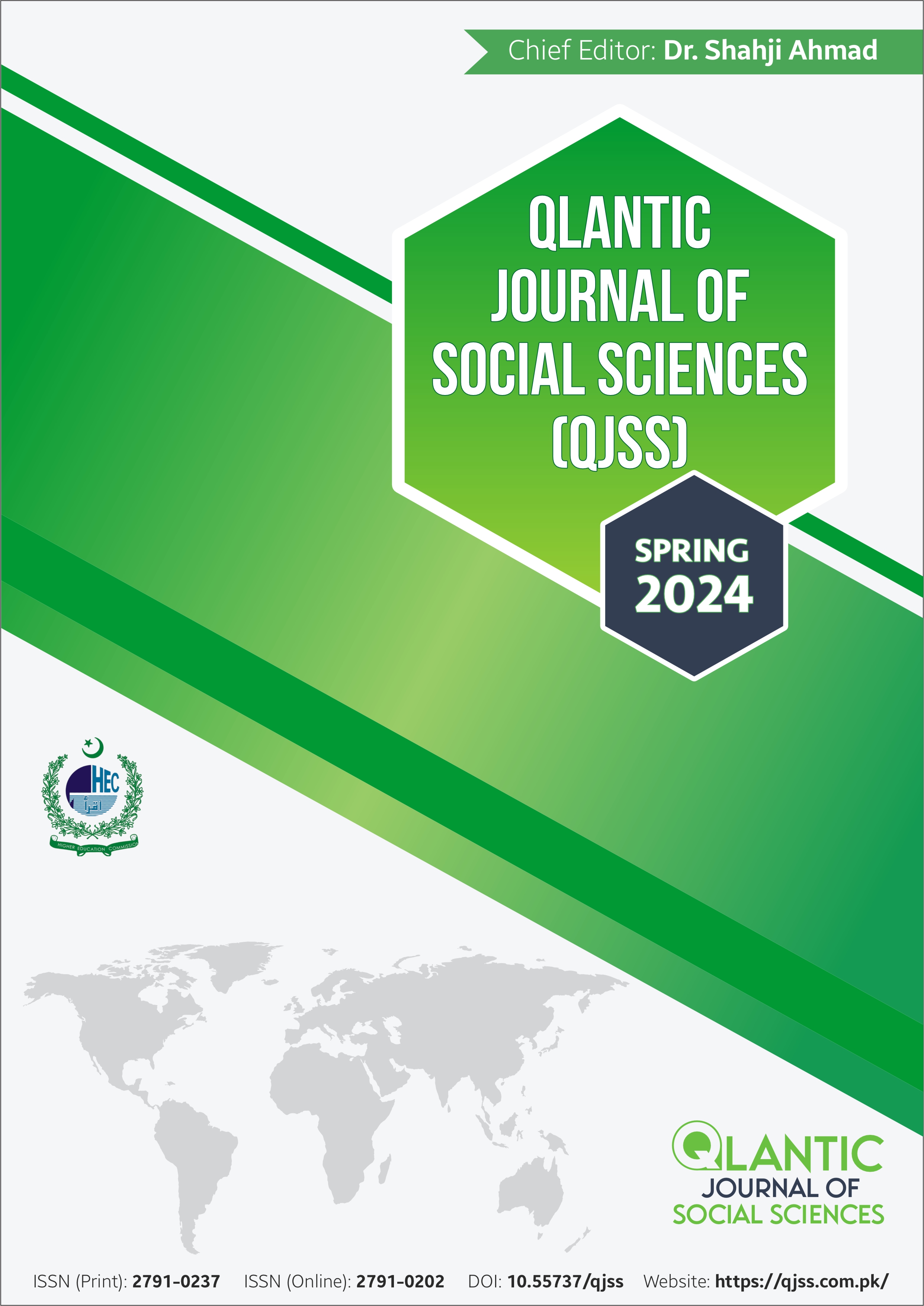Bloom’s Taxonomy and Prospective Teachers’ Preparation in Pakistan
DOI:
https://doi.org/10.55737/qjss.791335465Keywords:
Bloom’s Taxonomy, Prospective Teachers, Pakistani University ContextAbstract
The analysis of application of Bloom's Taxonomy in the future teachers’ preparation of Pakistan is the aim of this study where gender differences, program differences and semester effects are considered. The researchers developed questionnaire and examined the data using IBM SPSS statistics software. The results point to the fact that female participants are more likely than men to display mastery of lower-level skills as defined by Bloom's taxonomy, such as "remembering" and "understanding, and males tend to excel at thinking critically and analytically, i.e. "analyzing" and "evaluating" according to Bloom's taxonomy. On the other hand, the students of the first, second and third years of the Bachelor of Education (B.Ed.) program were found to be scoring higher than M.Phil. participants. Additionally, freshman students were shown to have stronger achievements at the earlier levels of Bloom's Taxonomy compared to later-year students. These inferences, therefore, indicate the necessity of personalized educational strategies as well as staff development programs to raise the standards of education in Pakistani schools
References
Adhitya, Y. (2024). Analysis of Prospective Teacher Students Errors in Making Math Test Instruments Based on Bloom’s Taxonomy Revised. Eduscape: Journal of Education Insight, 2(1), 25–36. https://doi.org/10.61978/eduscape.v2i1.131
Akinboboye, J. T., & Ayanwale, M. A. (2021). Bloom taxonomy usage and psychometric analysis of classroom teacher made test. African Multidisciplinary Journal of Development, 10(1), 10–21.
Amer, A. (2006). Reflections on Bloom’s revised taxonomy. Electronic Journal of Research in Educational Psychology, 4(1), 213–230. https://www.redalyc.org/pdf/2931/293123488010.pdf
Aşıkcan, M., & Uygun, N. (2023). A taxonomic analysis of the questions prepared by prospective primary teachers for primary school mathe matics and Turkish language courses. International Journal of Education and Literacy Studies, 11(3), 286-293. https://doi.org/10.7575/aiac.ijels.v.11n.3p.286
Barrientos, D. D. (2023). Assessing the Knowledge of Teachers in Objective Test Construction Procedure in the Teacher Education Programs. International Journal for Multidisciplinary Research, 5(5), 1–13. https://www.ijfmr.com/papers/2023/5/5874.pdf
Bashir, S., Karim, T., & Akram, N. (2020). Teachers focus to practice formative assessment techniques and blooms taxonomy: Assessment of class practices of prospective teachers. Journal of Arts & Social Sciences, 7(2), 116-125. https://doi.org/10.46662/jass-vol7-iss2-2020(116-125)
Begam, A. A. A., & Tholappan, A. (2018). Psychomotor domain of Bloom’s taxonomy in teacher education. Shanlax International Journal of Education, 6(3), 11–14. https://www.shanlaxjournals.in/journals/index.php/education/article/view/14
Byrd, P. A. (2002). The Revised Taxonomy and Prospective Teachers. Theory Into Practice, 41(4), 244–248. https://doi.org/10.1207/s15430421tip4104_7
Domínguez-González, M. D., Hervás-Gómez, C., Díaz-Noguera, M. D., & Reina-Parrado, M. (2023). Attention to diversity from artificial intelligence. The European Educational Researcher, 6(3), 101-115. https://doi.org/10.31757/euer.633
ElJishi, Z., Abdel-Hameed, F. S., Khuddro, A., & Zayed, S. Y. (2024). Translating bloom’s taxonomy action verb list into Arabic for teacher preparation programs: Challenges/Problems and solutions. International Journal of Education and Literacy Studies, 12(1), 295-303. https://doi.org/10.7575/aiac.ijels.v.12n.1p.295
Khizar, A., Anwar, M. N., & Zainab, G. (2020). Does it matter to assess the high order thinking skills among prospective teacher educators. International Review of Social Sciences, 8(11), 163–170.
Kocakaya, S., & Kotluk, N. (2016). Classifying the Standards via Revised Bloom’s Taxonomy: A Comparison of Pre-Service and In-Service Teachers. International Journal of Environmental and Science Education, 11(18), 11297–11318. https://files.eric.ed.gov/fulltext/EJ1120794.pdf
Küchemann, S., Steinert, S., Revenga, N., Schweinberger, M., Dinc, Y., Avila, K. E., & Kuhn, J. (2023). Can ChatGPT support prospective teachers in physics task development? Physical Review Physics Education Research, 19(2), 020128. https://doi.org/10.1103/PhysRevPhysEducRes.19.020128
Lisnawati, S., Rosidah, N. S., & Afrianto, Y. (2023). Project Assessment Based Learning Evaluation Module For Prospective Teacher Students. Journal of Research Administration, 5(2), 6075–6086. https://journalra.org/index.php/jra/article/view/763
Mohammadi, E., Kiany, G. R., Samar, R. G., & Akbari, R. (2015). Appraising pre-service EFL teachers’ assessment in language testing course using revised Bloom’s taxonomy. International Journal of Applied Linguistics and English Literature, 4(4), 8–20. https://doi.org/10.7575/aiac.ijalel.v.4n.4p.8
Nurhayati, N., Suhandi, A., Muslim, M., & Kaniawati, I. (2023). Analysis of teachers and prospective physics teachers’ difficulties in implementing problem-based learning model to improve students’ 4c skills. Journal of Physics: Conference Series, 2596(1), 012058. https://doi.org/10.1088/1742-6596/2596/1/012058
Ramya, R., & Rajeswari, G. (2023). Prospective Teachers’perception Towards The Role of Cloud-Based LMS for Quality Sustenance in Education. Mite Journal of Education, 1.
Sa'dijah, C., Murtafiah, W., Anwar, L., & Sa'diyah, M. (2023). Exploring the content knowledge of prospective mathematics teacher students in designing HOTS questions. THE 5TH INTERNATIONAL CONFERENCE ON MATHEMATICS AND SCIENCE EDUCATION (ICoMSE) 2021: Science and Mathematics Education Research: Current Challenges and Opportunities. https://doi.org/10.1063/5.0113669
Seaman, M. (2011). BLOOM’S TAXONOMY. Curriculum & Teaching Dialogue, 13.
Tuncer, H., Özkan, Y., & Bada, E. (N.D.). Progression of Questioning Skills of Pre-Service English Language Teachers in Practicum: A Study on Revised Bloom’s Taxonomy. Studies in Humanities, 18.
Zhou, Y., Gan, L., Chen, J., Wijaya, T. T., & Li, Y. (2023). Development and validation of a higher-order thinking skills assessment scale for pre-service teachers. Thinking Skills and Creativity, 48, 101272. https://doi.org/10.1016/j.tsc.2023.101272




